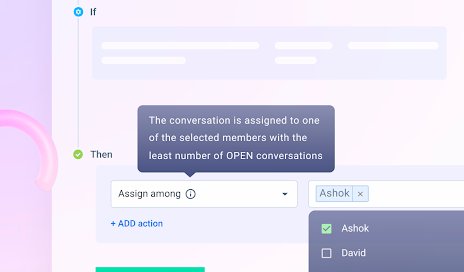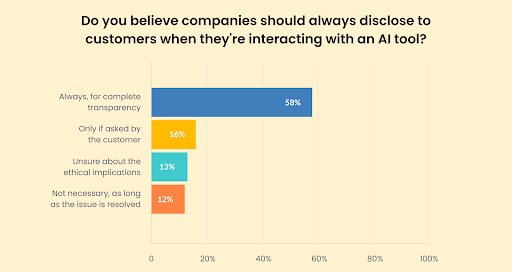12 Ways Businesses Can Use AI in Customer Service

Table of contents
The rise of Artificial Intelligence (AI) in customer service is transforming how businesses interact with their customers. This shift is driven by the need to meet growing customer expectations for quick, efficient, and personalized support. AI is at the forefront of this change, offering innovative solutions that are reshaping customer service.
A key trend here is the move towards a collaborative model where AI enhances human capabilities. This is highlighted in our recent survey report – “AI vs Human: The Future of Customer Service” – where we found out that 50% of customer support experts expect AI to work alongside humans.
Table of Contents
- What is AI in Customer Service?
- Benefits of AI in Customer Service
- 12 Ways to Use AI in Customer Service
- Way Forward

This insight marks a significant change from viewing AI as a replacement for human interaction to seeing it as an enabler in providing superior customer service.
In this article, we explore 12 ways in which businesses can effectively use AI in their customer service operations. These strategies are vital for companies aiming to stay competitive and boost customer satisfaction.
What is AI in Customer Service?
AI in customer service refers to the application of Artificial Intelligence technologies to automate, enhance, and optimize various aspects of customer support. This involves using machine learning algorithms, natural language processing (NLP),and other AI methodologies to understand, predict, and respond to customer needs and inquiries.
AI-driven systems in customer service can interpret and process large volumes of data, including text and voice, enabling them to engage with customers in a human-like manner. These systems learn from past interactions and improve their responses over time, offering increasingly accurate and relevant assistance.
Top 9 AI Customer Support Software
Benefits of AI in Customer Service
The integration of AI in customer service offers a multitude of benefits for both businesses and customers. Here are some key advantages:
- Improved Efficiency and Productivity: AI can handle routine inquiries and tasks, allowing human customer service agents to focus on more complex issues. This leads to quicker resolution times and a more efficient use of human resources.
- 24/7 Availability: AI-powered chatbots and virtual assistants can provide round-the-clock service, ensuring that customers receive immediate assistance at any time, without the limitations of human working hours.
- Personalized Customer Experience: AI can analyze customer data and past interactions to offer tailored recommendations and solutions, making the customer experience more personalized.
- Scalability: AI systems can handle a large volume of queries simultaneously, which is particularly beneficial for businesses experiencing rapid growth or seasonal spikes in customer service requests.
- Data-Driven Insights: AI tools can gather and analyze customer data, providing valuable insights into customer behavior, preferences, and trends. This information enables data-driven decision making, allowing businesses to improve service strategies and product offerings.
- Proactive Service: AI can predict customer needs and issues before they arise, allowing businesses to proactively address them.
- Language and Communication Barriers Reduction: AI-powered tools with multilingual capabilities can bridge the communication gap with customers from different linguistic backgrounds, broadening the reach of your business.
See How Harvey – Hiver’s AI Bot Can Supercharge Your Team’s Productivity
12 Ways to Use AI in Customer Service
Leveraging AI in customer service has a myriad of benefits. We decided to put together 12 use cases where you can implement AI and visibly see its benefits.
1. AI-Powered Chatbots for Instant Customer Support
AI-powered chatbots are one of the most effective tools in modern customer service. These chatbots, combined with reliable customer service software, use natural language processing (NLP) and machine learning to understand and respond to customer inquiries in real-time.
Unlike traditional scripted chatbots, AI-driven chatbots can handle a wide range of queries with a more human-like, conversational approach. They can assist with everything from answering basic questions and guiding users through website navigation, to troubleshooting common problems.
Consider a telecom company that implements an AI chatbot on its website and mobile app. A customer visits the website, looking to upgrade their plan. The chatbot initiates a conversation, understands the customer’s request through natural language processing, and guides them through the available plan options, helping them choose and activate a new plan – all without human intervention.
Pro-Tip:
When implementing an AI chatbot, ensure it is well-integrated with your existing customer service database and CRM systems. This integration allows the chatbot to access relevant customer data, providing more personalized and accurate responses. Additionally, regularly update and train your AI models with new data and customer interaction scenarios to improve the chatbot’s performance over time.
2. Predictive Customer Service Using AI Analytics
Predictive customer service harnesses AI’s power to analyze vast amounts of data and predict customer needs or issues before they arise. By utilizing machine learning algorithms and data analytics, businesses can identify patterns and trends in customer behavior.
This proactive approach allows companies to address potential issues, offer timely solutions, or even tailor their services and products to meet anticipated needs.

For instance, a retail company might use AI analytics to monitor purchasing patterns and customer feedback. The system notices a trend where a particular product often leads to customer inquiries about installation two weeks after purchase. Anticipating this, the company proactively reaches out to customers who recently purchased this product, offering installation guides or scheduling a follow-up call with a technician.
Pro-Tip:
To effectively implement predictive customer service, focus on collecting and analyzing a wide range of data points – from transaction history and customer service interactions to social media feedback. The richer the data, the more accurate the predictions. Ensure compliance with data protection regulations to maintain customer trust. Regularly revisiting and refining your predictive models is key to keeping them relevant and effective in changing market conditions.
3. AI-Enhanced Self-Service Portals
AI-enhanced self-service portals empower customers to find answers and resolve issues on their own, without needing to interact directly with a customer service representative. These portals use machine learning and natural language processing to understand and respond to customer queries. They often include features like intelligent search bars, personalized FAQs, and interactive guides, which are continuously updated based on user interactions and feedback.

Like, a software company could implement an AI-enhanced self-service portal that includes an intelligent search function. When a user types in a query, the system not only provides relevant documentation but also suggests articles and tutorials based on the user’s past queries and product usage. If a user frequently searches for topics related to a specific software feature, the portal might proactively suggest advanced guides or tutorials for that feature.
Pro-Tip:
When designing an AI-enhanced self-service portal, prioritize user experience. The interface should be intuitive and easy to navigate. Use customer interaction data to constantly improve the portal. For instance, if many customers search for a specific issue, consider creating a dedicated resource or guide for that topic. Also, ensure there’s an easy option for customers to escalate their query to a human agent if the self-service portal doesn’t resolve their issue.
4. Automated Customer Service Ticketing with AI
Automated customer service ticketing systems powered by AI enhance the efficiency of handling customer inquiries. These systems automatically categorize, prioritize, and route customer service tickets to the appropriate department or personnel based on the content and urgency of the request. By analyzing the text within a service ticket using natural language processing, AI can understand the context and assign it accordingly, ensuring a faster and more accurate response.

For example, a financial services company could employ an AI-driven ticketing system to manage customer inquiries. When a customer submits a ticket about a disputed transaction, the AI system immediately categorizes it as high priority and routes it to the fraud department. Simultaneously, the system sends an automated response to the customer, acknowledging receipt of the ticket and providing an estimated response time.
Pro-Tip:
To maximize the efficiency of an AI-driven ticketing system, it’s crucial to train the AI model with a wide range of past tickets and responses. This training helps the system learn how to categorize and prioritize different types of inquiries. Additionally, maintain a feedback loop where customer service agents can flag misrouted tickets to continually improve the AI’s accuracy.
5. AI-Driven Sentiment Analysis for Customer Feedback
AI-driven sentiment analysis involves using natural language processing (NLP) and machine learning to analyze and interpret the emotional tone behind customer feedback, reviews, and interactions. This technology enables businesses to gauge customer sentiment – whether positive, negative, or neutral – and respond appropriately. By analyzing text from various sources such as social media, emails, and customer reviews, companies can gain insights into customer satisfaction, brand perception, and other areas needing improvement.
For instance, a restaurant chain could use sentiment analysis to monitor customer reviews and social media mentions. The AI system identifies a pattern of negative sentiments regarding wait time at several locations. Using this information, the management can take specific actions to address this issue, such as staffing adjustments or process improvements, thereby directly addressing customer concerns.
Pro-Tip:
When implementing sentiment analysis, it’s important to consider the nuances and context of language. AI models should be trained on a diverse dataset to understand different expressions, slang, and regional language variations. Additionally, integrate sentiment analysis with your customer relationship management (CRM) system to get a holistic view. Use these insights to guide business strategies and customer service policies.
6. Real-Time Language Translation for Global Customer Support
Real-time language translation powered by AI is a game-changer for global customer support. It allows businesses to offer assistance in multiple languages without the need for multilingual staff. This AI technology uses advanced natural language processing to accurately translate customer queries and responses in real-time, enabling seamless communication between customers and support staff regardless of language barriers.
Imagine an e-commerce platform that operates globally. A customer from Japan, who speaks limited English, sends a query in Japanese. The AI translation system instantly translates this message into English for the support team. The team’s response in English is then translated back into Japanese for the customer. This seamless process ensures effective communication, leading to a satisfactory customer service experience.
Pro-Tip:
When incorporating real-time translation, it’s crucial to choose a system that not only translates accurately but also understands cultural nuances and colloquialisms. Regularly updating and training the AI with new languages and dialects can enhance its effectiveness. Additionally, consider integrating a feedback mechanism where customers can rate the accuracy of the translation, helping you continuously improve the service.
7. AI-Enabled Personalization for Customer Interactions
AI-enabled personalization in customer service involves using AI technologies to deliver customized and relevant experiences to each customer. This approach uses data analytics and machine learning to understand individual customer preferences, behaviors, and history. Based on this understanding, AI systems can tailor interactions, recommendations, and solutions to fit the specific needs and preferences of each customer.
For instance, a streaming service uses AI to analyze viewing habits, ratings, and preferences of its users. When a user contacts customer support regarding content recommendations or technical issues, the AI system provides personalized suggestions and solutions based on the user’s viewing history and past interactions. This personal touch not only enhances the user’s experience but also fosters a deeper connection with the brand.
Pro-Tip:
To effectively implement AI-enabled personalization, it’s essential to have a robust data collection and analysis system in place. Ensure that the data used is relevant and up-to-date. Additionally, be transparent with customers about how their data is being used and provide options for them to control their data preferences.
In our recent survey report – AI vs Human: The Future of Customer Service – we found that 58% of customer support experts advocate for full transparency and disclosure to customers when using AI for support.

8. AI-Assisted Quality Control and Training
AI-assisted quality control and training involve using AI tools to monitor and analyze customer service interactions to ensure quality and consistency. This technology can identify areas where customer service representatives may need additional training or guidance. It can also pinpoint successful interaction patterns to be used as models for training. AI systems can evaluate factors like response time, resolution effectiveness, and customer satisfaction, providing objective insights that can be used for continuous improvement.
For instance, a telecommunications company employs AI to analyze recorded customer service calls. The AI system analyzes various parameters, such as the clarity of communication, adherence to protocols, and customer satisfaction. It identifies specific areas where certain agents excel and others where improvement is needed. The company then tailors its training programs based on these insights, leading to a more skilled and effective customer service team.
Pro-Tip:
When implementing AI for quality control and training, it’s important to balance the use of AI insights with human judgment. Use AI as a tool to provide data-driven insights, but keep the human element in decision-making, especially in nuanced or complex situations.
9. AI for Handling High-Volume Customer Interactions
AI is particularly effective in managing high-volume customer interactions, a common challenge for many businesses. During peak hours or seasonal events, volume of customer queries can surge and overwhelm traditional customer service systems. AI, with its ability to process and respond to multiple queries simultaneously, can handle these increased volumes efficiently. This capability ensures that customer inquiries are addressed promptly, maintaining a high level of service even under pressure.
For instance, an airline company experiences a surge in customer inquiries during the holiday season. To manage this, they deploy AI systems capable of handling thousands of interactions at once. The AI system sorts through the queries, responding immediately to common questions like baggage allowances or flight status, and escalating more complex issues to human agents. This approach reduces wait time and frees up human agents so that they can focus on more important tasks.
Pro-Tip:
To maximize the effectiveness of AI in handling high-volume interactions, it’s crucial to have a well-structured categorization system that can quickly identify and sort queries. Regularly train the AI system with updated information and scenarios, especially before anticipated high-traffic periods.
Additionally, ensure there’s a seamless handoff process to human agents for queries that require a more personal touch or are too complex for AI to handle.
10. AI-Driven Customer Journey Mapping
AI-driven customer journey mapping involves using artificial intelligence to analyze and understand the various touchpoints and paths customers take when interacting with a business. This process involves collecting and interpreting data from multiple channels to create a detailed map of the customer’s experience, from initial contact to post-purchase support. AI algorithms can identify patterns, pain points, and opportunities for enhancement throughout the customer journey, enabling businesses to optimize their interactions and improve the overall customer experience.
For instance, an online retailer uses AI to track and analyze customer interactions across their website, customer service channels, and social media platforms. The AI identifies that many customers drop off at a specific point in the checkout process. Further analysis reveals that this is due to unclear shipping options. Armed with this insight, the retailer simplifies the checkout process, leading to a decrease in cart abandonment and an increase in sales.
Pro-Tip:
For AI-driven customer journey mapping, ensure comprehensive data collection across all customer touchpoints. The more data the AI has, the more accurate its analysis and insights will be. Also, it’s crucial to continuously update and refine the AI algorithms as customer behaviors and preferences evolve.
11. Integrating AI with Multichannel Support
Integrating AI with multichannel support involves using AI technologies to provide a seamless service experience across multiple channels, such as email, social media, live chat, phone calls, and more. AI helps in synchronizing information and interactions across these channels, ensuring that customers receive personalized and coherent support regardless of how they choose to contact a business.

For instance, a consumer electronics company offers support through email, chat, and phone. AI integration ensures that when a customer, who previously sent an email about an issue, calls the support number, the phone support agent has immediate access to the email history. This continuity eliminates the need for the customer to repeat information, making the support experience extremely effortless.
Pro-Tip:
To successfully integrate AI with multichannel support, ensure that your AI system has access to a unified customer database that consolidates information from all channels. This database should be updated in real-time to provide the most current information.
12. AI for Real-Time Performance Analytics and Feedback
This involves using AI tools to monitor and analyze the effectiveness of customer service interactions as they happen. AI technology provides instant feedback to customer service agents, allowing for immediate adjustments and improvements. AI algorithms can assess various aspects of a customer interaction, such as response time, problem-solving efficiency, and customer satisfaction, offering valuable insights.

For instance, a bank uses AI to monitor live chat sessions between customers and service agents. The AI system evaluates the interactions based on predefined metrics like issue resolution time and customer sentiment. If a conversation seems to be leading to a negative outcome, the AI system alerts a supervisor or a more experienced agent to intervene. This real-time feedback allows for immediate corrective action, enhancing customer satisfaction and providing valuable learning opportunities for the agents.
Pro-Tip:
Implementing real-time performance analytics requires a careful balance between monitoring data and adhering to privacy laws. It’s also important to ensure that agents are comfortable with the analytics tools and understand that they are meant for support and improvement, not just surveillance.
Way Forward
In conclusion, these 12 strategies highlight how integrating AI into customer service operations can be beneficial for your business. AI can handle routine tasks efficiently, leaving your team free to focus on more important things.
This is exactly what Harvey, the AI bot of Hiver, does. Harvey takes care of the repetitive work, allowing your customer service team to concentrate on more complex customer issues and requests.
Using AI like Harvey in customer service means your team can spend more time on what really matters – solving unique problems and building strong relationships with your customers. It’s about making the most of technology to enhance your team’s skills and improve customer satisfaction.
Get started with Hiver today. Free for 7 days.

































